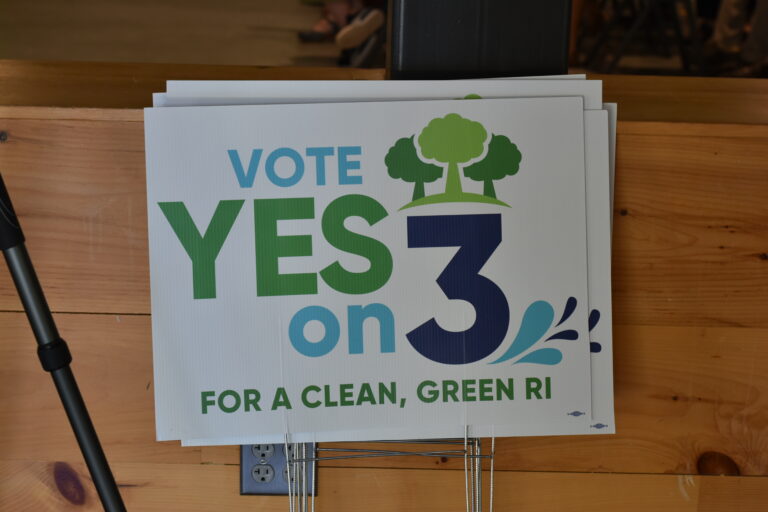Money would fund climate resilience programs and low- or no-interest loans for small business green energy projects
By Rob Smith / ecoRI News staff
State officials are asking voters this fall to approve $50 million in new borrowing to replenish key environmental programs across the state, and build a new carbon-neutral education facility at Roger Williams Park Zoo.
The
programs to be funded by Question 3 include:
$16
million for municipal climate resilience programs, as administered by the Rhode
Island Infrastructure Bank (RIIB).
$12
million for Roger Williams Park Zoo to construct a brand-new education facility
and event pavilion, with an eye toward expanding the educational programs
offered to Rhode Island students at the park.
$5
million for RIIB to provide zero-interest or below market rate loans to small
businesses for implementing green energy projects that will save money,
increase energy efficiency, and lower their carbon footprint.
$3
million for Narragansett Bay and watershed restoration, to be distributed as
matching funds for federal dollars.
$3
million for forest health management and wildlife habitat projects.
$4
million to replenish funds in the Rhode Island Department of Environmental
Management’s brownfield remediation program.
$5
million for open space grants available for municipalities and for expanding
state conservation areas.
$2
million for local recreation grants to create new or improve already existing
recreational facilities across the state.
State leaders remained bullish on the environment at a Question 3 campaign kickoff on Tuesday. Gov. Dan McKee stressed the importance of land conservation, noting that together with The Nature Conservancy, he had protected over 500 acres of land as mayor of Cumberland.
“It’s
what we do today that pays dividends down the line,” said McKee.
Tuesday’s
kickoff venue was specifically chosen as an example of what environmental bond
money can accomplish. The Farm Fresh Rhode Island facility,
located on Sims Avenue in Providence, received three separate grants from DEM:
for brownfield remediation, stormwater management and climate resiliency. All
three grants sourced their funding from environmental bond questions approved
by voters in past elections.
Board
member Lucie Searle said the building, which opened in November 2020, was
constructed on precise specifications to reduce polluted runoff, and to protect
against sea level rise, the building was built two feet higher.
Those
efforts have paid results. “We did not have one problem here with flooding
[last month],” Searle said, referring to the intense rain events that flooded
many areas of the state earlier this year.
The
60,000-square-foot Farm Fresh RI complex channels all of its runoff into 370
stormwater chambers buried at least six feet below ground onsite. These
chambers capture water, filter it for pollutants and return the clean runoff
back into the groundwater. The facility’s grounds include several bioretention
gardens: “A fancy word for depressions [in the ground],” quipped Searle.
Many of the DEM programs slated to be funded by the new bond are among the agency’s most successful and most popular. The agency has noted in the past that it frequently receives far more applications for recreational facilities grants from cities and towns than it can approve.
In
May, state officials announced more
than $4 million for recreational grants from the last round of environmental
bond funding. The awarded projects included $400,000 for improvements to Jenks
Park in Central Falls, $400,000 for Knightsville Park in Cranston, and $312,500
for the city of Woonsocket to acquire 1.37 acres adjacent to Silvestri Pond.
The
recreation grant program by DEM has helped fund nearly 550 projects totaling
$80 million since 1988. According to the Outdoor Industry Association, outdoor
recreation in Rhode Island generates $2.4 billion in consumer spending and
supports 24,000 jobs.
Providence
Mayor Jorge Elorza said parks were a priority when he was elected in 2014. Some
of the capital city’s parks hadn’t seen major upgrades or innovations since the
1970s. The mayor instituted a goal that every city resident live within a
10-minute walk to a city park, a goal the mayor said his administration blew
past years ago.
“We
don’t have sprawling yards,” said Elorza. “The parks are our backyards [in the
city].”
DEM’s
brownfield remediation program has had similar successes. The program, which
often works in tandem with matching federal grants from the Environmental Protection Agency,
has been instrumental in redeveloping dozens of brownfields across Rhode Island
and in the state’s former industrial core.
A
brownfield is any property where expansion, reuse or redevelopment may be
complicated by the potential or known presence of hazardous substances,
pollutants and contaminants, a definition which includes in Rhode Island
hundreds if not thousands of sites, given the state’s past as a heavy
industrial center.
Many
of these sites are clustered along urban riverfronts. The Tidewater Landing
project has made more waves than
its developers probably expected along the Seekonk River throughout its
redevelopment process. But an ecoRI News review of the
city’s other brownfields within 200 feet of the city’s riverfront shows 19 out
of 22 are fully remediated, if not redeveloped.
Since
1996, the EPA has sent $46 million to Rhode Island for brownfield remediation
and related activities, with Pawtucket receiving $3,423,921 of those funds.
Rhode Island DEM provided the Pawtucket brownfield sites with another
$1,121,365 in assessment grants, used to investigate what toxic materials
reside within the properties.
Among
nine brownfield sites at Branch Street in Pawtucket, repeated investigations
since the 1970s have found arsenic, lead and polycyclic aromatic hydrocarbons
(PAHS), and petroleum products in the soil and groundwater. After a lengthy
remediation process, today the parcels along Branch Street have 29
affordable-housing units across four buildings overlooking the Blackstone
River.
If
approved by voters this fall, the Question 3 green projects bond will be the
fourth time since 2016 state leaders have borrowed money to fund key
environmental programs. The total for the previous three environmental bonds is
$127 million.
The
governor said the state’s finances remain strong.
“Our
state is in a position not just to borrow money, but also to pay it back,” said
McKee.
